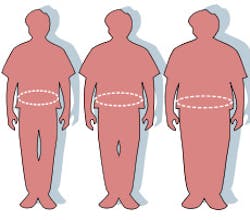Lose weight to stay healthy
An expert Work Group developed five questions to address a revision in the 1998 Clinical Guidelines on the Identification, Evaluation, and Treatment of Overweight and Obesity in Adults — The Evidence Report.(3) They are: What are the benefits of losing weight, and how much weight loss is needed to achieve them? Are established cutpoints for overweight and obesity appropriate across different populations? What is the best diet? What is the best lifestyle intervention? What are the benefits and risks of various bariatric surgical procedures?(2)
A review identified Key Points of the new guidelines.(2)
• All overweight and obese patients should be counseled that losing weight (initial goal, 5%-10% over 6 months) is associated with reductions in LDL, triglycerides, blood glucose, glycated hemoglobin (HgA1c) and diabetes risk, blood pressure, and medication use, as well as increases in HDL (Class I).
• Measures and cutpoints for identification of patients at increased risk for cardiovascular disease, type 2 diabetes, and all-cause mortality remain unchanged: body-mass index (overweight, ≥25 kg/m2; obese, ≥30 kg/m2) as the first screening step (Class I), and waist circumference (>88 cm in women, >102 cm in men) for further risk assessment (Class IIa).
• Any prescribed diet should reduce caloric intake (Class I) and be balanced with increased energy demands. Of the myriad diets reviewed, none was found to be ideal for weight loss or superior to any of the others.
• The most effective comprehensive lifestyle interventions (combining diet, physical activity, and behavioral strategies) are on-site, high-intensity (>14 sessions in 6 months), and delivered in group or individual sessions by a trained interventionist for 1 year or more (Class I).
• Bariatric surgery may be appropriate in patients with a BMI of ≥40 kg/m2 — or ≥35 kg/m2 with comorbidity — who have not responded to comprehensive lifestyle therapy (Class IIa). The most effective surgical method depends on many clinical variables (Class IIb); physicians should refer patients considering this option to an experienced bariatric surgeon.
For more information on “Evaluating Obesity Prevention Efforts: A Plan for Measuring Progress (2013),” visit the National Academies Press website.(4)




